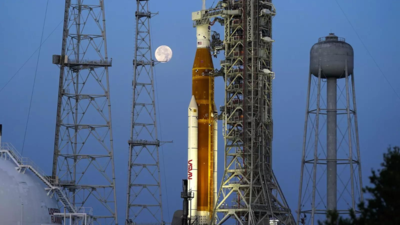Top Searches
- News
- India News
- Back to the moon: All you need to know about Nasa's Artemis I launch and India's contribution
Back to the moon: All you need to know about Nasa's Artemis I launch and India's contribution

NEW DELHI: Nasa's colossal next-generation rocketship Artemis, which will eventually take humans back to the moon after a gap of over 50 years, will make its debut launch on Monday at 6:03pm (IST).
The uncrewed, six-week test flight around the moon and back is the first mission of the space agency's Artemis programme, successor to Apollo.

The Artemis programme - named for the goddess who was Apollo's twin sister in ancient Greek mythology - aims to return astronauts to the moon's surface as early as 2025, and to establish a long-term lunar colony as a stepping stone to even more ambitious future voyages sending humans to Mars.
Top 10 points about Nasa's historic launch
India connect
Chandrayaan-1’s discovery of lunar water helped revitalise global interest in exploring the Moon.
On November 14, 2008, India had released the Moon Impact Probe onboard Chandrayaan-1 orbiter to impact into the Shackleton crater, which eventually helped confirm the presence of water ice.
On September 24, 2009, Nasa reported that its Moon Mineralogy Mapper (M3) spectrometer onboard Chandrayaan-1 probe had detected "absorption features" on the surface of the Moon.
In August 2018, Nasa confirmed that M3 showed water ice is present on the surface at the Moon poles. Water was also confirmed to be on the sunlit surface of the Moon on October 26, 2020.
India is planning to land a rover on the moon during its Chandrayaan-3 mission in 2023.
Back to the moon
Twelve astronauts walked on the moon during six manned Apollo missions that landed from 1969 to 1972, the only spaceflights yet to place people on the lunar surface.
Neil Armstrong became the first person to walk on the moon on July 20, 1969, during the Apollo 11 mission. Eugene Andrew Cernan was the last man to have walked on the moon during the Apollo 17 mission in December 1972.
If successful, Artemis I will pave the way for a crewed SLS-Orion mission, an out-and-back flight around the moon designated Artemis II, as early as 2024. This will be followed a year or more later by an Artemis III mission to the lunar surface -- over half-a-century after the last moon landing.
Nasa intends to launch crewed flights around once a year beginning with Artemis 3.
Long way to go
Artemis III involves a much higher degree of complexity, integrating the SLS-Orion with a series of spacecraft to be built and flown by Elon Musk's launch company SpaceX.
This includes SpaceX's own heavy-duty Starship launch and lunar-landing vehicle, still under development, as well as several components that remain to be constructed such as an orbital fuel depot and space tankers. Even the new moon-walking suits remain to be designed.
Nasa's Office of Inspector General last year said that the first Artemis III lunar landing was more likely to be achieved two to three years later than the agency's late 2025 target date.
The southern pole of the Moon will be the site of Nasa's first crewed spaceship landing. Moon landings have previously taken place near the equator.
To Mars
A space station dubbed Gateway will be built as part of the Artemis programme and will orbit the Moon. The living quarters module and power and propulsion system are scheduled to be launch by a SpaceX Falcon Heavy rocket in late 2024.
The Gateway will be put together by Orion personnel. A lander that will enable them to go to the Moon and back will eventually be available to astronauts after they spend 30-60 days in Gateway. Additionally, Gateway would act as a pit station on any future trips to Mars.
Nasa has chosen Elon Musk's SpaceX to construct the Moon lander. The shuttle from the Orion crew capsule to the lunar surface and back will be provided by SpaceX's Starship, which is still in development.
(With inputs from agencies)
The uncrewed, six-week test flight around the moon and back is the first mission of the space agency's Artemis programme, successor to Apollo.

The Artemis programme - named for the goddess who was Apollo's twin sister in ancient Greek mythology - aims to return astronauts to the moon's surface as early as 2025, and to establish a long-term lunar colony as a stepping stone to even more ambitious future voyages sending humans to Mars.
Top 10 points about Nasa's historic launch
- The 32-story-tall, two-stage
Space Launch System (SLS) rocket and itsOrion crew capsule will blast-off from the Kennedy Space Center in Cape Canaveral, Florida, on Monday. - The maiden voyage of the SLS-Orion, a mission dubbed Artemis I, is intended to put the 5.75-million-pound vehicle through its paces in a rigorous demonstration flight, pushing its design limits, before Nasa deems it reliable enough to carry astronauts.
- Billed as the most powerful, complex rocket in the world, the SLS represents the biggest new vertical launch system the US space agency has built since the Saturn V flown during the Apollo moon program of the 1960s and 70s.
- The spacecraft will take off from the historic Launch Pad 39B, which was also used for the Apollo mission.
- The rocket's four main R-25 engines and its twin solid-rocket boosters produce 8.8 million pounds of thrust, about 15% more thrust than produced by the Saturn V.
- About 90 minutes after launch, the rocket's upper stage will thrust Orion out of Earth orbit on course for a 42-day flight that will bring it to within 60 miles of the lunar surface before sailing 40,000 miles (64,374 km) beyond the moon and back to Earth. The capsule is expected to splash down in the Pacific on October 10.
- Although no humans will be aboard, Orion will be carrying a simulated crew of three - one male and two female mannequins - fitted with sensors to measure radiation levels and other stresses that real-life astronauts would experience.
- A top objective for the mission is to test the durability of Orion's heat shield during re-entry as it hits Earth's atmosphere at 24,500 miles (39,429 km) per hour, or 32 times the speed of sound, on its return from lunar orbit - much faster than more common re-entries of astronaut capsules returning from low-Earth orbit.
- Re-entry friction is expected to raise temperatures outside the capsule to nearly 5,000 degrees Fahrenheit (2,760 Celsius).
- More than a decade in development with years of delays and billions of dollars in budget overruns, the SLS-Orion spacecraft has so far cost Nasa least $37 billion, including design, construction, testing and ground facilities.
India connect
Chandrayaan-1’s discovery of lunar water helped revitalise global interest in exploring the Moon.
On November 14, 2008, India had released the Moon Impact Probe onboard Chandrayaan-1 orbiter to impact into the Shackleton crater, which eventually helped confirm the presence of water ice.
On September 24, 2009, Nasa reported that its Moon Mineralogy Mapper (M3) spectrometer onboard Chandrayaan-1 probe had detected "absorption features" on the surface of the Moon.
In August 2018, Nasa confirmed that M3 showed water ice is present on the surface at the Moon poles. Water was also confirmed to be on the sunlit surface of the Moon on October 26, 2020.
India is planning to land a rover on the moon during its Chandrayaan-3 mission in 2023.
Back to the moon
Twelve astronauts walked on the moon during six manned Apollo missions that landed from 1969 to 1972, the only spaceflights yet to place people on the lunar surface.
Neil Armstrong became the first person to walk on the moon on July 20, 1969, during the Apollo 11 mission. Eugene Andrew Cernan was the last man to have walked on the moon during the Apollo 17 mission in December 1972.
If successful, Artemis I will pave the way for a crewed SLS-Orion mission, an out-and-back flight around the moon designated Artemis II, as early as 2024. This will be followed a year or more later by an Artemis III mission to the lunar surface -- over half-a-century after the last moon landing.
Nasa intends to launch crewed flights around once a year beginning with Artemis 3.
Long way to go
Artemis III involves a much higher degree of complexity, integrating the SLS-Orion with a series of spacecraft to be built and flown by Elon Musk's launch company SpaceX.
This includes SpaceX's own heavy-duty Starship launch and lunar-landing vehicle, still under development, as well as several components that remain to be constructed such as an orbital fuel depot and space tankers. Even the new moon-walking suits remain to be designed.
Nasa's Office of Inspector General last year said that the first Artemis III lunar landing was more likely to be achieved two to three years later than the agency's late 2025 target date.
The southern pole of the Moon will be the site of Nasa's first crewed spaceship landing. Moon landings have previously taken place near the equator.
To Mars
A space station dubbed Gateway will be built as part of the Artemis programme and will orbit the Moon. The living quarters module and power and propulsion system are scheduled to be launch by a SpaceX Falcon Heavy rocket in late 2024.
The Gateway will be put together by Orion personnel. A lander that will enable them to go to the Moon and back will eventually be available to astronauts after they spend 30-60 days in Gateway. Additionally, Gateway would act as a pit station on any future trips to Mars.
Nasa has chosen Elon Musk's SpaceX to construct the Moon lander. The shuttle from the Orion crew capsule to the lunar surface and back will be provided by SpaceX's Starship, which is still in development.
(With inputs from agencies)
FOLLOW US ON SOCIAL MEDIA
FacebookTwitterInstagramKOO APPYOUTUBE
Start a Conversation
end of article










